OpenCV2.4.4图像旋转和缩放
旋转变换公式的推导: 如下图,在2维坐标上,有一点$p(x, y)$,直线op的长度为r,直线op和x轴的正向的夹角为a。直线op围绕原点做逆时针方向b度的旋转,到达$p'(s,t)$
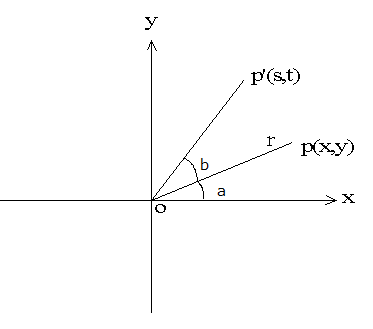
则有 $ s = r cos(a+b) = r cos(a) cos(b) - r sin(a) sin(b) \tag{1.1} $ $ t = r sin(a+b) = r sin(a) cos(b) - r cos(a) sin(b) \tag{1.2} $ 其中$x = r cos(a)$, $y = r sin(a)$ 代入(1.1), (1.2) ,得 $ s = x cos(b) - y sin(b) \tag{1.3} $ $ t = x sin(b) + y cos(b) \tag{1.4} $ 用行列式表示如下 $$ \left( \begin{array}{c} s \ t \end{array}
\right)
\left( \begin{array}{cc} cos(b) & -sin(b) \ sin(b) & cos(b) \end{array} \right) \left( \begin{array}{c} x \ y \end{array} \right) $$
用到的一些OpenCV中的函数:
CvMat*cv2DRotationMatrix(CvPoint2D32f center, double angle, double scale, CvMat*map_matrix);
Mat getRotationMatrix2D(Point2f center, double angle, double scale );
- 说明:计算旋转加缩放的仿射矩阵
- 参数:
- center:旋转中心
- angle:旋转度数,正值表示逆时针旋转。
- scale:各方向同性的缩放尺度
- map_matrix:输出参数,仿射变换矩阵,浮点型2*3矩阵
- 返回值:仿射变换矩阵
- 注意:默认的变换是以相反的顺序进行的,即从目标到源。对于目标图像中的任一点(x,y),先计算出它在源图像中的坐标,再将此点的像素值拷贝到目标图像中,所以计算出的变换矩阵是从目标到源的变换矩阵。
例如逆时针旋转30度,不做缩放,计算出的变换矩阵为: $$ \left( \begin{array}{ccc} 0.866025, &0.5, &-91.5064 \ -0.5, &0.866025, &158.494 \end{array} \right) $$
void cvWarpAffine(const CvArr* src,CvArr* dst, const CvMat* map_matrix,
intflags=CV_INTER_LINEAR+CV_WARP_FILL_OUTLIERS, CvScalar fillval=cvScalarAll(0) );
void warpAffine(InputArray src, OutputArray dst, InputArray M, Sizedsize, int flags=INTER_LINEAR,
int borderMode = BORDER_CONSTANT, constScalar& borderValue=Scalar() );
- 说明:对图像做仿射变换
- 参数:
- M:输入参数,2×3的仿射变换矩阵
- dsize:输出图像的尺寸
- flags:差值方法,若设置WARP_INVERSE_MAP标识,指明M是目的到源的变换。
- borderMode:边界处理方法
- 注意:当设置标志位WARP_INVERSE_MAP时,目标图像的计算公式为:$ dst(x,y)=src(M_{11}x+M_{12}y+M_{13}, M_{21}x+M_{22}y+M_{23}) $
否则,先调用
invertAffineTransform()计算出M的逆仿射变换M',然后将M'带入以上公式进行变换。
#include<iostream>
#include<opencv2/imgproc/imgproc.hpp>
#include<opencv2/highgui/highgui.hpp>
using namespace std;
using namespace cv;
#define SCALE 0.5 //缩放比例
int main()
{
Mat src = imread("pic3.png");
Mat dst;//输出图像
int angle = 30;//旋转角度(正值表示逆时针旋转)
int length;//输出图像的宽度或高度
//为了保证无论如何旋转都能放下,输出图像的长和宽都设为输入图像对角线长度乘以SCALE
//但如果是缩小(SCALE<=1),这样会导致临时图像中放不下原图,所以对于所有缩小的情况,输出图像和临时图像的长宽都设为原图的对角线长度
if(SCALE <= 1)
length = sqrt(src.cols*src.cols + src.rows*src.rows);
else
length = sqrt(src.cols*src.cols + src.rows*src.rows) * SCALE;
//建立临时图像,长宽都是源图像的对角线长度,将源图像复制到临时图像的中心后再变换
Mat tempImg(length,length,src.type());//临时图像,大小和输出图像一样大
int ROI_x = length/2 - src.cols/2;//ROI矩形左上角的x坐标
int ROI_y = length/2 - src.rows/2;//ROI矩形左上角的y坐标
Rect ROIRect(ROI_x,ROI_y,src.cols,src.rows);//ROI矩形
Mat tempImgROI2(tempImg,ROIRect);//tempImg的中间部分
src.copyTo(tempImgROI2);//将原图复制到tempImg的中心
Point2f center(length/2,length/2);//旋转中心
Mat M = getRotationMatrix2D(center,angle,SCALE);//计算旋转的仿射变换矩阵
//输出看看算出的矩阵是什么
cout<<"变换矩阵:"<<endl;
cout<<M.at<double>(0,0)<<","<<M.at<double>(0,1)<<","<<M.at<double>(0,2)<<","<<endl;
cout<<M.at<double>(1,0)<<","<<M.at<double>(1,1)<<","<<M.at<double>(1,2)<<","<<endl;
warpAffine(tempImg,dst,M,Size(length,length));//仿射变换
//显示
imshow("src",src);
imshow("tempImg",tempImg);
imshow("dst",dst);
waitKey(0);
return 0;
}
效果图:
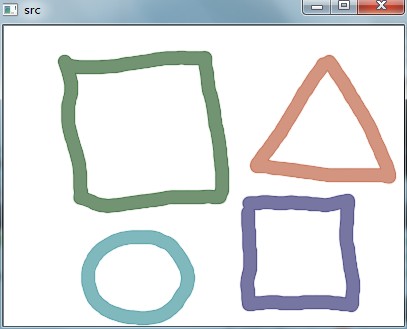
原图

临时图像1
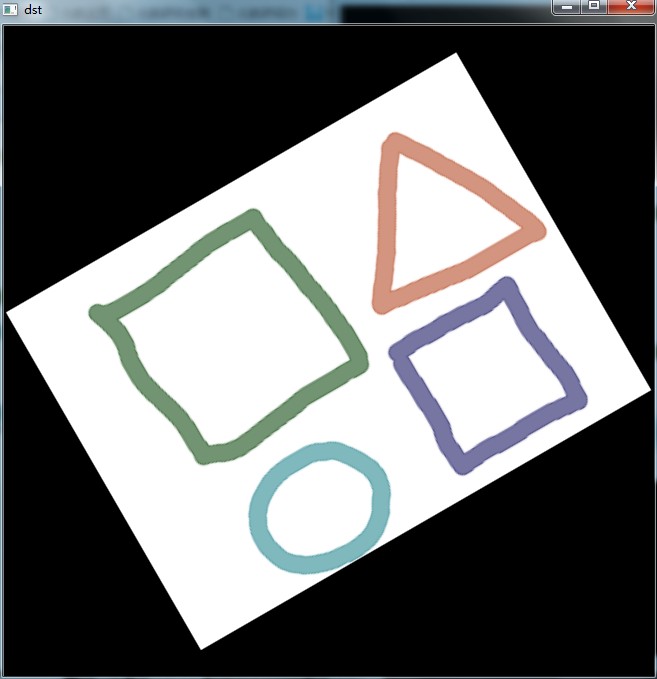
结果1
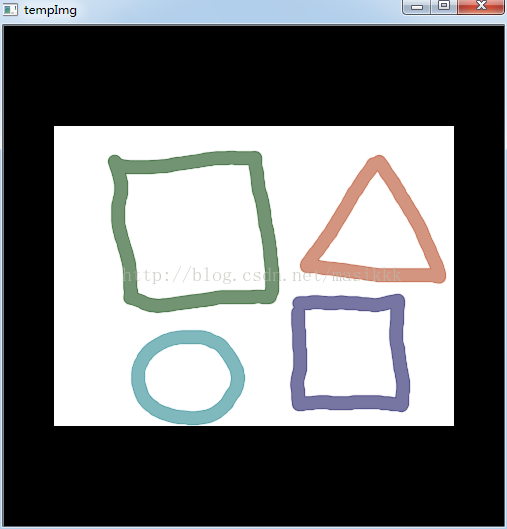
临时图像2
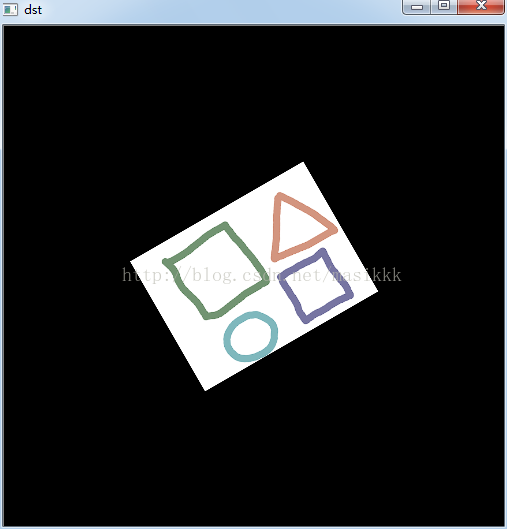
结果2